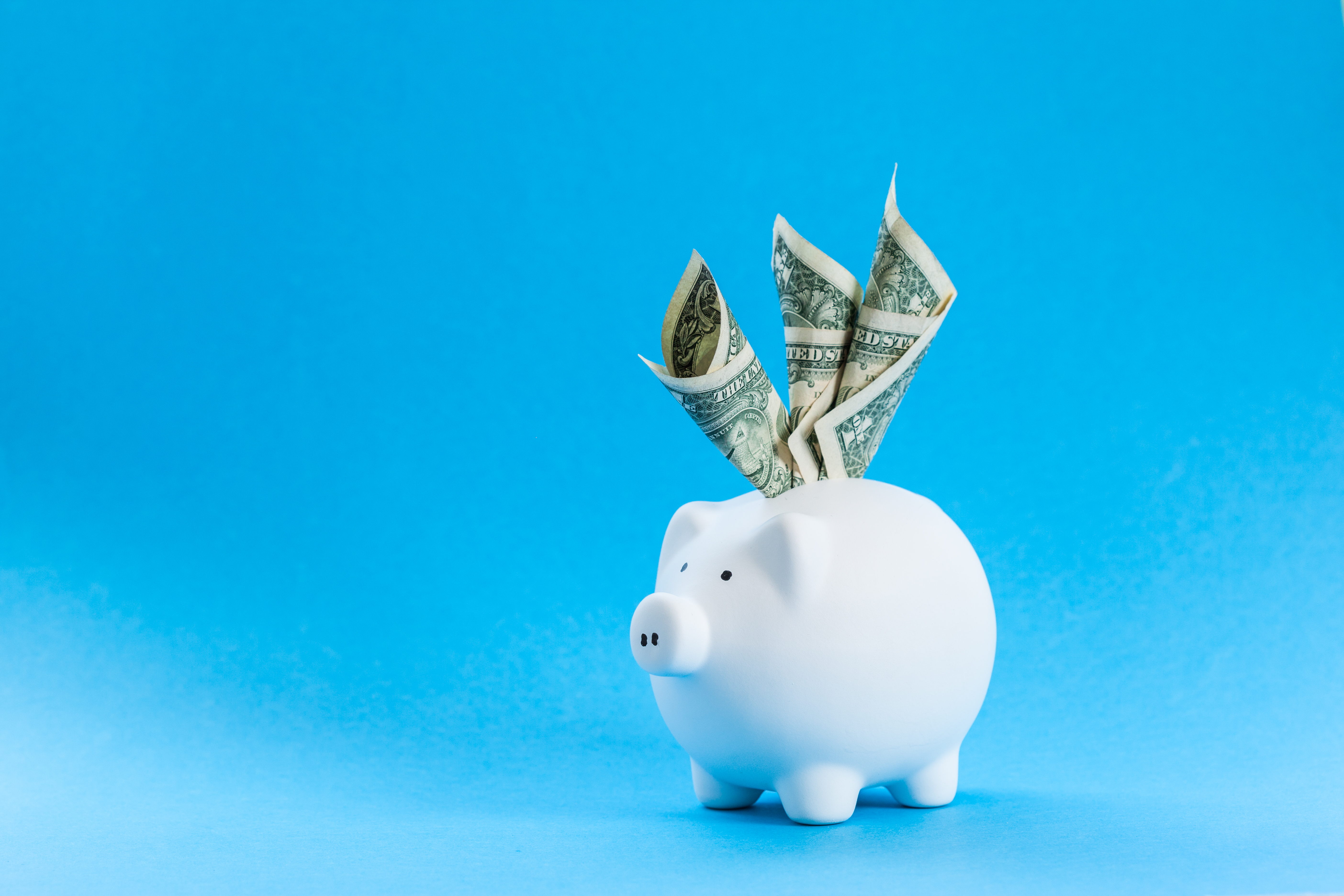3 Dividend Aristocrats to Hold for the Next 10 Years
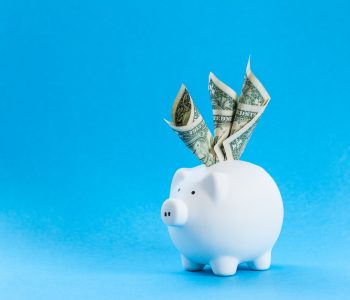
These Dividend Aristocrats Can Provide Long-Term Income & Growth
After 2022, a year in which the S&P 500 ended up deep in correction territory and the Nasdaq was in a bear market, stock investors are justifiably worried about another roller coaster ride in 2023.
Despite persistently high inflation, rising interest rates, and fears of a recession, the S&P 500 gained 6.2% in January, marking its best January in four years. Meanwhile, the Dow Jones Industrial Average climbed by 2.8%, its third positive month in the last four. The Nasdaq Composite climbed by 10.7%, for its best January since 2001 and best monthly performance since July 2022.
Stocks have been rallying, but by all accounts, it’s not the start of a bull market; it’s another bear market rally. There simply aren’t enough signs of strengthening fundamentals to support bullish sentiment. The disconnect between the stock market rally and market fundamentals suggests that stocks could experience volatility over the coming months and quarters. This unpredictability underscores the importance of investing in solid, well-established companies that have a history of long-term share-price gains and reliably growing dividends.
These kinds of stocks can help investors navigate near-term volatility and headwinds. They can also provide investors with reliable monthly or quarterly passive income. They’re the kinds of stocks Warren Buffett says investors should hold forever.
In theory, it’s easier to decide to buy a stock than it is to decide when to sell it. There’s no guarantee the stock’s value will go up or the company’s fundamentals will remain the same over time. Most investors buy and sell at the wrong times.
When asked what criteria he uses to determine when to sell a stock, Buffett said, “Well, the best thing to do is buy a stock that you don’t ever want to sell.” (Source: “Morning Session – 1998 Meeting,” CNBC, November 9, 2018.)
One of Buffett’s mantras is to buy shares that he’s happy to own for the rest of his life. And if a particular stock sells off and its valuation goes a lot lower than before, Buffett has said it makes sense to add more of the shares to his portfolio.
In addition to stocks with a long history of strong capital appreciation, what other kinds of stocks does Buffett like? Dividend stocks.
Buffett’s own company, Berkshire Hathaway (NYSE:BRK.B), doesn’t pay dividends, but that doesn’t prevent him from investing in other companies that provide growing dividends. Each year, the stocks in his portfolio give him more than $6.0 billion in dividend income. (Source: “Form 13F,” United States Securities and Exchange Commission, last accessed February 15, 2023.)
For investors with a long-term investing horizon, be it 10 years, 25 years, or more, dividend aristocrats—S&P 500 companies that have raised their dividends for at least 25 consecutive years—are the best place to start looking.
To be able to increase its dividends for at least a quarter of a century, a business needs to make a ton of money no matter what. Whether they’re facing a recession, war, pandemic, or another type of black swan event, dividend aristocrat companies sell products and/or services that people need. They rake in a lot of money and return a large portion of that money to investors in the form of growing dividends.
Not only is it nice to get annual pay raises from dividend aristocrats, but in terms of share price, these stocks tend to outperform the S&P 500 over the long term. As a result, they’re a fabulous way to fight inflation and stock market volatility.
3 Dividend Stocks to Hold Forever
If you want to invest like Warren Buffett and you’re looking to hold a stock for 10 years or more, the following three stocks are worth considering.
Coca-Cola
Coca-Cola Co (NYSE:KO) is the world’s largest non-alcoholic beverage company, selling about 200 master brands in more than 200 countries and territories. It distributes its products through unmatched infrastructure that includes about 225 bottling partners, 900 bottling plants, and 30 million retail customer outlets. (Source: “Company Profile,” Coca-Cola Co, last accessed February 15, 2023.)
The company’s beverages include sparkling soft drinks, juices, waters (including flavored waters), sports drinks, and ready-to-drink teas and coffees. Some of the company’s most popular brands are “Coca-Cola,” “Costa Coffee,” “Dasani,” “fairlife,” “Fanta,” “Honest Tea,” “Minute Maid,” and “Powerade.”
Coca Cola stock is a great example of bad things happening to a good stock. The company is an industry juggernaut that is highly profitable, has steady earnings growth, and has a low debt. This is probably why Berkshire Hathaway Inc has 400 million shares of KO stock, roughly 9.3% of the cNYSE: CAPLcocompany.
For fiscal 2022, Coca Cola announced that its net revenue increased by 11%, its organic revenue climbed by 16%, its operating income grew by six percent, and its adjusted earnings climbed by seven percent. (Source: “Coca-Cola Reports Fourth Quarter and Full-Year 2022 Results,” Coca-Cola Co, February 14, 2023.)
Another reason to love Coca-Cola stock is its dividends, which management has raised for 60 consecutive years.
In 2022, the company paid dividends totaling $7.6 billion. In February 2022, the company’s board approved KO stock’s 60th consecutive annual dividend increase, lifting the quarterly dividend per share by five percent from $0.42 to $0.44. Coca-Cola stock has maintained that payout ever since. (Source: “Board of Directors of The Coca-Cola Company Announces 60th Consecutive Annual Dividend Increase and Net Share Repurchase Outlook,” Coca-Cola Co, February 17, 2022.)
The company has a history of raising its dividend in the first quarter, and there’s no reason to think it won’t do the same in 2023.
| Dividend Yield | Annual Increases | 5-Year Return | 10-Year Return | 20-Year Return | 30-Year Return | 40-Year Return | 50-Year Return |
| 3.0% | 60 Years | 58% | 122% | 417% | 930% | 16,475% | 16,814% |
Dividends aren’t the only way in which Coca-Cola Co returns value to its shareholders. In 2022, the company purchased $1.4 billion worth of its own shares. The company’s remaining share repurchase authorization stands around $8.0 billion.
The financial outlook for Coca-Cola is solid. For 2023, management expects the company’s organic revenue to grow by up to eight percent, its adjusted earnings per share to grow in the range of four to five percent, and its free cash flow to be approximately $9.5 billion.
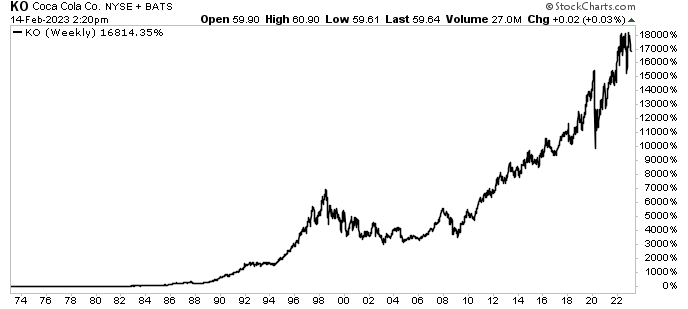
Chart courtesy of StockCharts.com
Johnson & Johnson
When it comes to income and growth, it’s tough to beat Johnson & Johnson (NYSE:JNJ). The company has been providing investors with significant capital appreciation for decades, and has raised its dividends for the last 60 straight years.
Johnson & Johnson is the world’s largest and most diverse health-care firm. It has entrenched positions in the consumer health, medical device, and pharmaceutical markets. Each day, its 142,000 employees serve more than one billion people. Over the course of one week, the company serves almost the same number of people who live on the planet. (Source: “2021 Investor Fact Sheet,” Johnson & Johnson, last accessed February 15, 2023.)
About 70% of its sales come from No. 1 or No. 2 global market share positions. Johnson & Johnson currently has 29 platforms/products that generate in excess of $1.0 billion in annual sales.
The company’s Pharmaceutical and Medical Device business segments represent close to 80% of its sales, which drive the majority of its cash flow. Its Pharmaceutical division focuses on cardiology, immunology, metabolic diseases, neurology, oncology, and pulmonary health. Its Medical Device division focuses on orthopedics, surgery tools, vision care, and a few smaller areas.
Johnson & Johnson’s Consumer Health segment focuses on baby care, oral care, over-the-counter medicines, skin health/beauty, women’s health, and wound care. Some of its most popular brands in this division are “Band-Aid,” “Listerine,” “Neutrogena,” and “Tylenol.”
Despite its already-massive product portfolio, the company still develops new products. About 25% of the company’s sales currently come from products launched in the past five years.
Even during recessions, housing market crises, pandemics, wars, or other black swan events, investors have benefited from JNJ stock’s share-price gains and reliable dividend increases.
Alex Gorsky, Johnson & Johnson’s chairman and CEO, said in the company’s 2020 fourth-quarter and full-year financial report, “Johnson & Johnson was built for times like these, and I am extremely confident in our ability to deliver lasting value and continued innovation in 2021 and for years to come.” (Source: “Johnson & Johnson Reports 2020 Fourth-Quarter and Full Year Results,” Johnson & Johnson, January 26, 2021.)
He wasn’t wrong. The company reported tremendous financial results in 2021, with continued strength across all segments of its business.
That momentum continued in 2022. Joaquin Duato, Johnson & Johnson’s chairman and CEO, commented, “As we look ahead to 2023, Johnson & Johnson is well-positioned to drive near-term growth, while also investing strategically to deliver long-term value.” (Source: “Johnson & Johnson Reports Q4 and Full-Year 2022 Results,” Johnson & Johnson, January 24, 2023.)
Speaking of value, the company has, as previously noted, increased its dividends for the last 60 years. It currently pays a quarterly dividend of $1.13 per share. The company has a history of raising its dividend in the second quarter of the year. (Source: “Dividend History,” Johnson & Johnson, last accessed February 15, 2023.)
| Dividend Yield | Annual Increases | 5-Year Return | 10-Year Return | 20-Year Return | 30-Year Return | 40-Year Return | 50-Year Return |
| 2.8% | 60 Years | 40% | 180% | 441% | 2,484% | 14,162% | 19,132% |
Given the company’s consistently wonderful financial results, well-known brands, and innovative product pipeline, Johnson & Johnson is well positioned for success in 2023 and beyond.
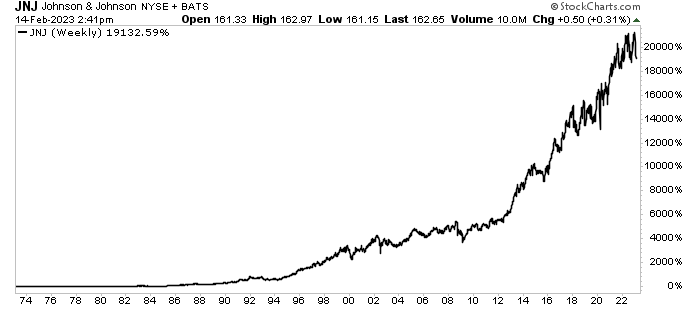
Chart courtesy of StockCharts.com
AFLAC
Insurance can be a mind-numbing topic, but insurance stocks provide some of the best long-term investment returns. This is why investing icons like Warren Buffett, Carl Icahn, and Prem Watsa invest in insurance companies. Insurance stocks’ history of outperforming the broader market makes them especially important these days since it looks more and more certain we’ll be entering a recession this year.
Insurance companies are cash cows. When we get insurance, we pay premiums that are based on a variety of calculations that, like with casinos, favor the house. The higher our risk, the more we pay for premiums. Furthermore, if you’re lucky enough to never need to make a claim, it means you’ve been paying the insurance company monthly premiums to receive nothing except—as the insurance companies will tell you—peace of mind.
It doesn’t hurt that rising interest rates boost insurance companies’ bottom lines. How? In many cases, insurance companies use the money they rake in to invest in bonds, which are sensitive to interest rates.
One insurance company that has been rewarding buy-and-hold investors for decades is AFLAC Incorporated (NYSE:AFL). It’s the world’s most recognized supplemental insurance company, providing health and life insurance to more than 50 million people. (Source: “Investor Presentation,” AFLAC Incorporated, February 14, 2023.)
The firm operates through two segments, Aflac U.S. and Aflac Japan. The U.S. segment provides accident/disability, critical care, life, and “other health” insurance. The Japan segment provides cancer, life, and “medical and other health” insurance. It also offers child endowment and income support policies.
Like most insurance companies, AFLAC makes a lot of money. For 2022, it reported total revenues of $19.5 billion and net earnings of $4.2 billion, or $6.59 per share. (Source: “Aflac Incorporated Announces Fourth Quarter Results,” AFLAC Incorporated, February 1, 2023.)
In the fourth quarter of 2022, the company announced that it would be increasing its quarterly dividend by five percent year-over-year to $0.42 per share.
| Dividend Yield | Annual Increases | 5-Year Return | 10-Year Return | 15-Year Return | 20-Year Return | 30-Year Return | 40-Year Return |
| 2.4% | 40 Years | 76% | 258% | 225% | 570% | 4,338% | 59,641% |
Also in 2022, AFLAC purchased 39.2 million of its own common shares for approximately $2.4 billion. At the end of 2022, the company had 116.6 million remaining shares authorized for repurchase.
Daniel P. Amos, AFLAC Incorporated’s chairman and CEO, stated, “We treasure our track record of dividend growth and remain committed to extending it, supported by the strength of our capital and cash flows. At the same time, we remain in the market repurchasing shares with a tactical approach, focused on integrating the growth investments we have made in our platform to improve our strength and leadership position.” (Source: Ibid.)
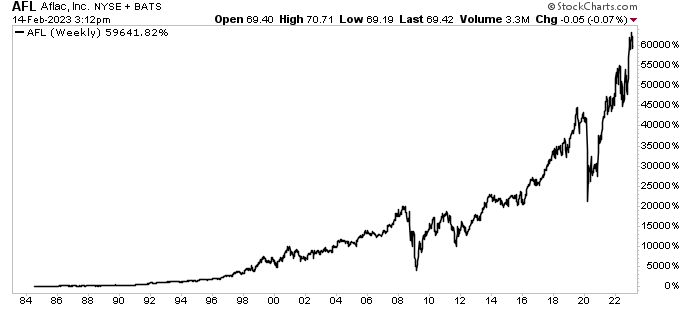
Chart courtesy of StockCharts.com
The Lowdown on “Forever” Dividend Aristocrats
Dividend aristocrats are a great option for investors who are looking for growing passive income and long-term capital appreciation.
Not only do dividend aristocrats perform well in various market conditions, but they also have high cash flow and healthy balance sheets, which allows them to pay growing dividends.




